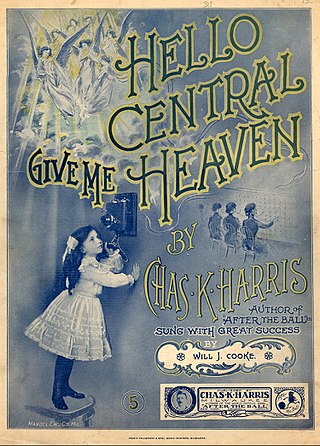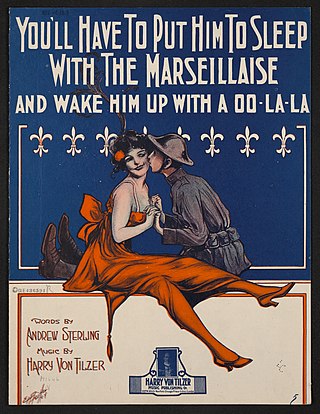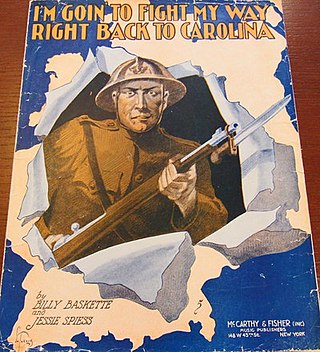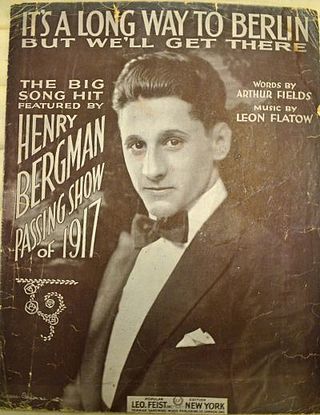
Alfred Bryan was a Canadian lyricist.
Harry Rubenstein, known professionally as Harry Ruby, was an American actor, pianist, composer, songwriter and screenwriter, who was inducted into the Songwriters Hall of Fame in 1970. He was married to silent film actress Eileen Percy.
Edgar Leslie was an American songwriter.
George William Meyer was an American Tin Pan Alley songwriter. He was born in Boston, Massachusetts, in 1884. He graduated from Roxbury High School, and began working in accountancy for Boston department stores, before moving to New York City in his mid-20s.

Hello Central, Give Me Heaven is a popular Tin Pan Alley song first published in 1901, with lyrics and music by Charles K. Harris, and was among Harris's most popular songs. It was first recorded by Byron G. Harlan and released in July 1901.

You'll Have to Put Him to Sleep with the Marseillaise and Wake Him Up with a Oo-La-La is a World War I song written in 1918. Andrew B. Sterling wrote the lyrics, and Harry Von Tilzer composed the music. The song was produced by the Harry Von Tizler Publishing Company in New York City. On the cover of the sheet music is a soldier kissing a woman. The song was written for both voice and piano.

I'm Going to Follow the Boys (Novelty Song) is a World War I era song released in 1917. Howard Rogers wrote the lyrics and James V. Monaco composed the music. The song was published by M. Witmark & Sons in New York City.

"The Angel God Sent From Heaven" is a World War I era American song published in 1918. Frank L. Ventre composed the music, while Paul A. Smith and Robert Levenson wrote the lyrics. It was published by Jack Mendehlsohn Music Company in Boston, Massachusetts. The song was written for both voice and piano. The cover was illustrated by the Dobinson Engraving Company. On the cover is a drawing of a nurse. Under her picture is a car and soldiers.

"Gee! What a Wonderful Time We'll Have When the Boys Come Home" is a World War I era song released in 1917. Lyrics and music were written by Mary Earl. The song was published by Shapiro, Bernstein & Co. of New York, New York. It was written for both voice and piano. The sheet music cover was designed by artist Albert Wilfred Barbelle. On the cover are soldiers marching down a city street. A skyline is behind them, and the lights spell out, "Welcome Home."

"The Little Grey Mother Who Waits All Alone " is a World War I era song released in 1915. Bernard Grossman wrote the lyrics. Harry De Costa composed the music. The song was published by M. Witmark & Sons of New York, New York. Vitagraph actress Mary Maurice is featured on the cover, reading a book and holding a rose. It was written for voice and piano.

"I'm Goin' To Fight My Way Right Back to Carolina" is a World War I era song written and composed by Billy Baskette and Jessie Spiess. The song was published in 1918 by McCarthy & Fisher, Inc. of New York City. The sheet music cover was designed by Andre C. De Takacs. It features an armed soldier tearing through the cover. The song was written for both voice and piano.

"We Don't Want the Bacon (What We Want Is a Piece of the Rhine)" is a World War I–era song released in 1918. The lyrics were written by "Kid" Howard Carr and Harry Russell, and the music composed by Jimmie Havens. The song was published by Shapiro, Bernstein & Co. of New York City. On the cover is a soldier tearing through a large piece of bacon with his bayonet. A fearful-looking Kaiser Wilhelm II is standing on the bacon. It was written for voice and piano.

"I May Be Gone for a Long, Long Time" is a World War I era song released in 1917. It was featured in the 1917 stage production of Raymond Hitchcock and E. Ray Goetz's Hitchy-Koo. Lew Brown wrote the lyrics. Albert Von Tilzer composed the music. The song was published by Broadway Music Corp. of New York, New York. André De Takacs designed the sheet music cover. It features Grace La Rue's image blended into the clouds of an ocean scene. The song was written for both voice and piano.

"Goodbye, Ma! Goodbye, Pa! Goodbye, Mule, with Yer Old Hee-Haw!", also known as "Long Boy", is a World War I era song released in 1917. William Herschel wrote the lyrics. Barclay Walker composed the music. It was published by Shapiro, Bernstein & Co. of New York, New York. Garr Williams designed the sheet music cover. It features a morose-looking cartoon soldier leaving his farm. Farm animals, the soldier's parents, and his girlfriend look on and wave flags. It was written for both voice and piano.

"It's a Long Way to Berlin, but We'll Get There!" is a World War I era song released in 1917. Arthur Fields wrote the lyrics. Leon Flatow composed the music. Leo Feist, Inc. of New York City published the song. Rosenbaum Studios designed the sheet music cover. It features soldiers marching in formation. There is an inset photo of Maurice Burkhardt, Will J. Ward, Ed Morton, Jimmy Flynn, Willie Weston, or Francis Maguire that varies per edition. There is another version of the cover known as the "Popular edition". It features a photo of Henry Bergman.

"And He'd Say, 'Oo-La-La! Wee-Wee!'" is a World War I era song released in 1919. Lyrics and music were written by George Jessel and Harry Ruby. William Baker arranged the song. It was published by Waterson, Berlin & Snyder, Inc. of New York, New York. The song was written for voice and piano.

"Girls of France" is a World War I era song released in 1917. Al Bryan and Edgar Leslie wrote the lyrics. Harry Ruby composed the music. The song was published by Waterson, Berlin & Snyder Co. of New York, New York. Artist Albert Wilfred Barbelle designed the sheet music cover. It features a nurse in the foreground, and soldiers marching behind her. It was written for both voice and piano.

"The Ragtime Soldier Man" is a World War I era song released in 1912 and 1917. Irving Berlin wrote the lyrics and composed the music, basing it off his 1911 song "Alexander's Ragtime Band". The song was published by Waterson, Berlin & Snyder, Co. of New York, New York. Artist Pfeiffer designed the sheet music cover. It features a U.S. soldier holding his rifle and jumping over cannon balls. The song was written for voice and piano.
"The Dixie Volunteers" is a World War I song written and composed by Edgar Leslie and Harry Ruby. This song was published in 1917 by Waterson, Berlin & Snyder Co., in New York, NY.The sheet music cover, illustrated by Barbelle, features soldiers marching with an inset photo of Eddie Cantor.















